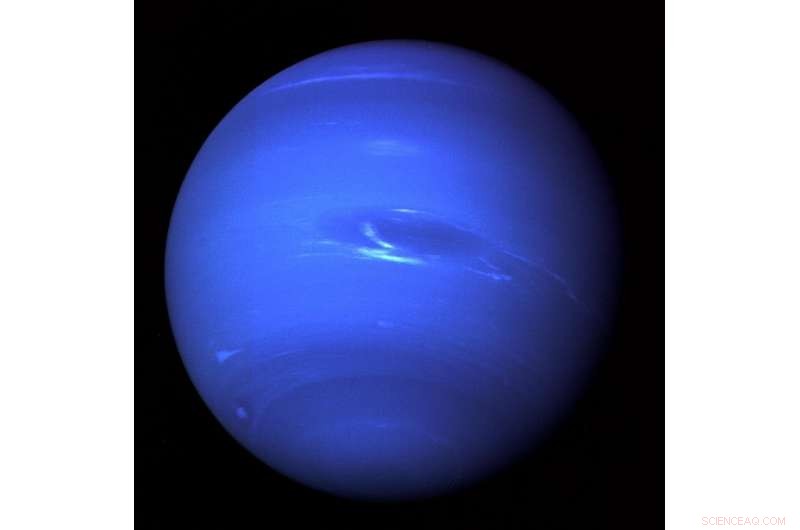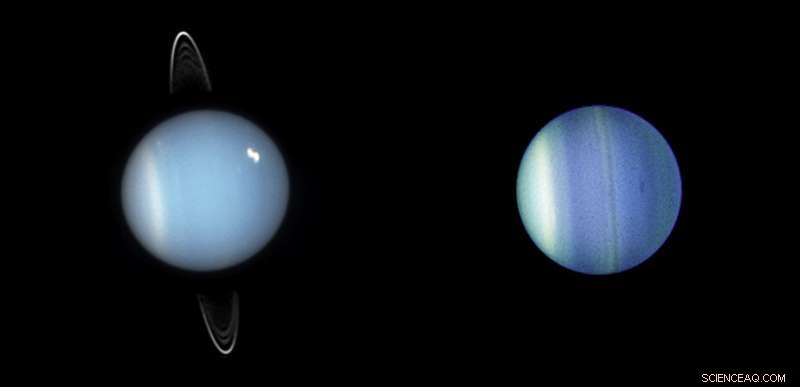
Esta imagem de Netuno da Voyager 2 mostra um mundo frio e escuro açoitado pelo vento. Em 1989, A Voyager 2 da NASA se tornou a primeira e única espaçonave a observar o planeta Netuno, passando cerca de 3, 000 milhas acima do pólo norte do planeta. Crédito:NASA / JPL-Caltech
Os longínquos Urano e Netuno - os gigantes de gelo de nosso sistema solar - são tão misteriosos quanto distantes. Logo após seu lançamento em 2021, O telescópio espacial James Webb da NASA mudará isso ao desvendar os segredos da atmosfera de ambos os planetas.
Os frios e remotos planetas gigantes Urano e Netuno são apelidados de "gigantes de gelo" porque seus interiores são composicionalmente diferentes de Júpiter e Saturno, que são mais ricos em hidrogênio e hélio, e são conhecidos como "gigantes gasosos". Os gigantes de gelo também são muito menores do que seus primos gasosos, sendo de tamanho intermediário entre os planetas terrestres e os gigantes gasosos. Eles representam a categoria menos explorada de planeta em nosso sistema solar. Cientistas que usam Webb planejam estudar os padrões de circulação, química e clima de Urano e Netuno de uma forma que só Webb consegue.
"A principal coisa que Webb pode fazer é muito, muito difícil de realizar a partir de qualquer outra instalação é mapear sua temperatura atmosférica e estrutura química, "explicou o líder dos estudos, Leigh Fletcher, professor associado de ciências planetárias na Universidade de Leicester, no Reino Unido. "Achamos que o tempo e o clima dos gigantes de gelo terão um caráter fundamentalmente diferente em comparação com os gigantes gasosos. Isso ocorre em parte porque eles estão muito distantes do Sol, eles são menores em tamanho e giram mais lentamente em seus eixos, mas também porque a mistura de gases e a quantidade de mistura atmosférica são muito diferentes em comparação com Júpiter e Saturno. "
Todos os gases nas atmosferas superiores de Urano e Netuno têm impressões digitais químicas únicas que Webb pode detectar. Crucialmente, Webb pode distinguir um produto químico de outro. Se esses produtos químicos estão sendo produzidos pela luz solar interagindo com a atmosfera, ou se eles estão sendo redistribuídos de um lugar para outro por padrões de circulação em grande escala, Webb será capaz de ver isso.
Esses estudos serão conduzidos por meio de um programa de Observações de Tempo Garantido (GTO) do sistema solar liderado por Heidi Hammel, um cientista planetário e Cientista Interdisciplinar Webb. Ela também é vice-presidente de Ciências da Associação de Universidades para Pesquisa em Astronomia (AURA) em Washington, O programa de D.C. Hammel demonstrará as capacidades de Webb para observar objetos do sistema solar e exercitar algumas das técnicas específicas de Webb para objetos que são brilhantes e / ou se movem no céu.
Urano:o planeta inclinado
Ao contrário dos outros planetas do nosso sistema solar, Urano - junto com seus anéis e luas - está inclinado para o lado, girando em aproximadamente um ângulo de 90 graus do plano de sua órbita. Isso faz com que o planeta pareça rolar como uma bola ao redor do sol. Essa orientação estranha - que pode ser o resultado de uma colisão gigantesca com outro protoplaneta massivo no início da formação do sistema solar - dá origem a estações extremas em Urano.
Quando a espaçonave Voyager 2 da NASA voou por Urano em 1986, um pólo estava apontando diretamente para o sol. "Não importa o quanto Urano gire, "Hammel explicou, "metade estava sob a luz do sol o tempo todo, e a outra metade estava na escuridão total. It's the craziest thing you can imagine."
Disappointingly, Voyager 2 saw only a billiard-ball smooth planet covered in haze, with only a scant handful of clouds. But when Hubble viewed Uranus in the early 2000s, the planet had traveled a quarter of the way around in its orbit. Now the equator was pointed at the Sun, and the entire planet was illuminated over the course of a Uranian day.
"Theory told us nothing would change, " said Hammel, "But the reality was that Uranus started sprouting up all kinds of bright clouds, and a dark spot was discovered by Hubble. The clouds seemed to be changing dramatically in response to the immediate change in sunlight as the planet traveled around the Sun."

These Hubble Space Telescope images show the varied faces of Uranus. On the left, Uranus in 2005 displays its ring system. The planet -- along with its rings and moons -- is tipped on its side, rotating at roughly a 90-degree angle from the plane of its orbit. In the Hubble close-up taken just one year later, Uranus reveals its banded structure and a mysterious dark storm. Crédito:NASA, ESA, and M. Showalter (SETI Institute); Right:NASA, ESA, L. Sromovsky and P. Fry (U. Wisconsin), H. Hammel (Space Science Institute), and K. Rages (SETI Institute)
As the planet continues its slow orbital trek, it will point its other pole at the Sun in 2028.
Webb will give insight into the powerful seasonal forces driving the formation of its clouds and weather, and how this is changing with time. It will help determine how energy flows and is transported through the Uranian atmosphere. Scientists want to watch Uranus throughout Webb's life, to build up a timeline of how the atmosphere responds to the extreme seasons. That will help them understand why this planet's atmosphere seems to go through periods of intense activity punctuated by moments of calm.
Neptune:A World of Supersonic Winds
Neptune is a dark, cold world, yet it is whipped by supersonic winds that can reach up 1, 500 miles per hour. More than 30 times as far from the Sun as Earth, Neptune is the only planet in our solar system not visible to the naked eye. Its existence was predicted by mathematics before its discovery in 1846. In 2011, Neptune completed its first 165-year orbit since its discovery.
Like Uranus, this ice giant's very deep atmosphere is made of a thick soup of water, amônia, hydrogen sulfide and methane over an unknown and inaccessible interior. The accessible upper layers of the atmosphere are made of hydrogen, helium and methane. As with Uranus, the methane gives Neptune its blue color, but some still-mysterious atmospheric chemistry makes Neptune's blue a bit more striking than that of Uranus.
"It's the same question here:How does energy flow and how is it transported through a planetary atmosphere?" explained Fletcher. "But in this case, unlike Uranus, the planet has a strong internal heat source. That heat source generates some of the most powerful winds and the most short-lived atmospheric vortices and cloud features of anywhere in the solar system. If we look at Neptune from night to night, its face is always shifting and changing as these clouds are stretched and pulled and manipulated by the underlying wind field."
Following the 1989 Voyager 2 flyby of Neptune, scientists discovered a bright, hot vortex—a storm—at the planet's south pole. Because the temperature there is higher than everywhere else in the atmosphere, this region is likely associated with some unique chemistry. Webb's sensitivity will allow scientists to understand the unusual chemical environment within that polar vortex.
Just the Beginning
Fletcher advises to be prepared for seeing phenomena on Uranus and Neptune that are totally unlike what we've witnessed in the past. "Webb really has the capability to see the ice giants in a whole new light. But to understand the continual atmospheric processes that are shaping these giant planets, you really need more than just a couple of samples, " he said. "So we compare Jupiter to Saturn to Uranus to Neptune, and by that, we build up a wider picture of how atmospheres work in general. This is the beginning of understanding how these worlds are changing with time."
Hammel added, "We now know of hundreds of exoplanets—planets around other stars—of the size of our local ice giants. Uranus and Neptune provide us ground truth for studies of these newly discovered worlds."
The James Webb Space Telescope will be the world's premier space science observatory when it launches in 2021. Webb will solve mysteries in our solar system, olhe além, para mundos distantes ao redor de outras estrelas, e sondar as misteriosas estruturas e origens de nosso universo e nosso lugar nele. Webb is an international program led by NASA with its partners, ESA (Agência Espacial Europeia) e Agência Espacial Canadiana.